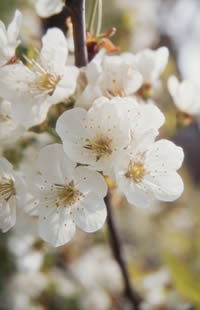Wild Cherry Prunus serotina

- Common Names
- Wild Cherry Bark , Black Cherry, chokecherry
- Botanical Name
- Prunus serotina
- Family
- ROSACEAE
Medicinal Uses & Benefits of Wild Cherry Bark
![]() How to Use|
Side Effects |
Plant & Garden|
Folklore
How to Use|
Side Effects |
Plant & Garden|
Folklore
- Medicinal Uses: * Bronchitis
* Colds
* Congestion
* Cough
* Sleep/Insomnia
- Properties: * Anodyne * Anti-inflammatory * Antiscrofulous * Astringent * Expectorant * Sedative
- Parts Used: bark, fruit
- Constituents: acetylcholine, hcn, kaempferol, p-coumaric acid, prunasin, quercetin, scopoletin, tannins
How to Use: Wild Cherry

Black Cherry is an old fashioned cough
remedy that is still a family favorite
Wild black cherry is a very effective herbal cough remedy. The main use of the bark is to still irritated, nagging coughs. Wild black cherry is used in many commercial cough products such as Smith Brothers, Lunden's and Vicks for the flavor as well as the decongestant and sedative properties.
Preparation Methods & Dosage :Use one teaspoon of the powdered bark to 1 cup of hot water up to 3 times daily as a warm infusion, or 2 teaspoons of bark syrup once daily
Wild Cherry Remedies
Wild Cherry Side Effects: Safe in recommended amounts, but not meant for long term use. Although prussic acid is highly poisonous, if wild cherry bark is used in medicinal doses, the low prussic acid content (0.07-0.16%) ensures that the remedy is quite safe.
Plant Description
This indigenous North American tree grows from 50 to 80 feet high, with white flowers that bloom in May. The rough, black separates naturally from the trunk, the root bark in the most valued and is the part used medicinally. The red tinged wood it is fine-grained and compact, and makes beautiful furniture.
Regional Traditions :North America *
History and Traditions & Folklore
Native Americans made a tea from the bark to help curtail diarrhea and sooth the lungs, and passed it's use on to the early colonial settlers who included wild cherry in many cough elixir.Buddhism teaches that Maya, the virgin mother of Buddha, was supported by a holy cherry tree during her pregnancy. In Danish folklore, a good crop of cherries was insured by having the first ripe fruit eaten by a woman shortly after her first child was born.
 It is a tree of Venus. Cherries, as they are of different tastes, so they are of different qualities. The sweet pass through the stomach and the belly more speedily, but are of little nourishment; the tart or sour are more pleasing to an hot stomach, procure appetite to meat, to help and cut tough phlegm, and gross humours; but when these are dried, they are more binding to the belly than when they are fresh, being cooling in hot diseases, and welcome to the stomach, and provokes urine. The gum of the Cherry-tree, dissolved in wine is good for a cold, cough, and hoarseness of the throat; mends the colour in the face, sharpens the eyesight, provokes appetite, and helps to break and expel the stone, and dissolved, the water thereof is much used to break the stone, and to expel gravel and wind.
It is a tree of Venus. Cherries, as they are of different tastes, so they are of different qualities. The sweet pass through the stomach and the belly more speedily, but are of little nourishment; the tart or sour are more pleasing to an hot stomach, procure appetite to meat, to help and cut tough phlegm, and gross humours; but when these are dried, they are more binding to the belly than when they are fresh, being cooling in hot diseases, and welcome to the stomach, and provokes urine. The gum of the Cherry-tree, dissolved in wine is good for a cold, cough, and hoarseness of the throat; mends the colour in the face, sharpens the eyesight, provokes appetite, and helps to break and expel the stone, and dissolved, the water thereof is much used to break the stone, and to expel gravel and wind.
Nicholas Culpeper, 1653











